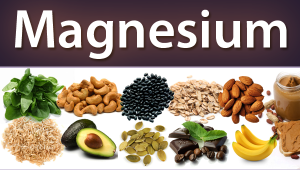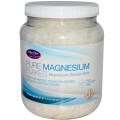Why is Magnesium Essential?
You’ve heard of essential vitamins – those your body doesn’t manufacture on its own so you have to consume them regularly (daily) in your diet. Well, magnesium is an essential mineral – which means getting adequate amounts of it in the foods you eat daily is essential for your life.

I don’t want to overload you with lists and statistics. However, if you read the following list, you cant help but be impressed by how important magnesium is for your overall health and function.
What are the benefits of magnesium?
- Magnesium is one of the five most common nutrient deficiencies in the SAD (Standard American Diet)
- Is readily available in whole foods, both vegetable and animal.
- Helps with bowel motility (constipation) via cellular metabolism and muscle function.
- Is necessary for 300+ enzyme systems that operate a healthy body.
- Required for: digestion, elimination, sleep, vitamin D function, brain, and bone health; bowel motility and serotonin production!- the neurotransmitter responsible for relaxation and feeling happy. Required by the cells to make ATP (Adenosine Triphosphate), the chemical energy of life!
- Builds muscles via Insulin-like Growth Factor (IGF-1).
- Supports flexible muscles, whereas calcium can harden muscles (and arteries).
- Prevents, asthma, heart attacks, psychiatric disorders, diabetes, migraines, frequent urination and hundreds of health issues.
- Reduces the damaging impact of stress on the nerves.
- Is absolutely necessary for the thyroid hormone, calcitonin, to activate bone building and regulate osteoblast/osteoclast activity, and is actually much more important to bone strength than calcium!
- Reduces errant chocolate cravings (and best of all, chocolate provides magnesium!)
- Enhances insulin receptivity on the cell membranes (mitochondrial membranes) and thus helps prevent and solve the diabetic “insulin-resistance” issue (along with other minerals such as chromium.)
A study published in BMC Bioinformatics found that your body has 3,751 magnesium binding sites. This indicates that magnesium benefits are far greater than previously imagined. Because your body requires and uses magnesium for so many different functions, you can quickly become low in magnesium especially if you are not consuming enough high magnesium foods.
Some of the major functions that require magnesium are:
- Protein synthesis
- Nerve function
- Blood sugar control
- Neurotransmitter release
- Blood pressure regulation
- Energy metabolism
- Production of the antioxidant glutathione
Are you getting enough magnesium-rich foods?
Magnesium deficiency is dramatically under-diagnosed because it doesn’t show up on a blood test! Only 1% of the magnesium in your body is stored in your blood, and the majority of it’s stored in your bones. Some of the main health challenges that have been linked to a magnesium deficiency include:
- Hormone imbalance and PMS
- Fibromyalgia
- Heart attack
- Type 2 diabetes
- Osteoporosis
- Constipation
- Tension or migraine headaches
- Anxiety and depression
- Chronic fatigue
As you can see, increasing your intake of high magnesium foods is essential to your health. For a more comprehensive list of magnesium deficiency symptoms read this Collective Evolution article, and see of you fall into those parameters. It also discusses cannabis use as a contributor to low magnesium levels.
How to increase your intake
If you think you might be low in magnesium, your best way to address this issue is to start consuming foods that are high in magnesium. Buying foods from your local farmers market and foods that are grown organically are likely to have higher levels of magnesium. The soil from conventional farms is depleted of magnesium because they don’t rotate their crops or let the land rest. Also, they typically only put nitrogen, phosphorus and potassium back in the soil, but leave out magnesium.
Typically, the foods you’ll find that are highest in magnesium are green leafy vegetables, which are packed with chlorophyll. Chlorophyll is known as the “life blood” of a plant and has the ability to absorb the sun’s light and turn it into energy.
The major difference between human blood and chlorophyll is that human blood has iron at the center of the cell, but plants have magnesium at the center of the cell.
Top 10 Magnesium Rich Foods Plus Proven Benefits
Magnesium-rich foods are essential for cellular health and over 300 biochemical functions in the body. Unfortunately, around 80 percent of American’s may have a magnesium deficiency, and the majority of them don’t even know it!
Green leafy vegetables aren’t the only foods rich in magnesium and chlorophyll. Here are the top 10 foods high in magnesium that you will want to add into your diet. From Dr Axe.com
- Spinach — 1 cup: 157 milligrams (40% DV) [1]
- Chard — 1 cup: 154 milligrams (38% DV)
- Pumpkin seeds — 1/8 cup: 92 milligrams (23% DV)
- Yogurt or Kefir — 1 cup: 50 milligrams (13% DV)
- Almonds — 1 ounce: 80 milligrams (20% DV)
- Black Beans — ½ cup: 60 milligrams (15% DV)
- Avocado — 1 medium: 58 milligrams (15% DV)
- Figs — ½ cup: 50 milligrams (13% DV)
- Dark Chocolate — 1 square: 95 milligrams (24% DV)
- Banana — 1 medium: 32 milligrams (8% DV)
If you you live with high stress, drink a lot of soda, or have specific symptoms of magnesium deficiency, you may want to boost your magnesium intake until you get your system in better balance.
Take it through the skin!
 Mark Sircus, OMD says the best form for human absorption and use is magnesium chloride, taken through the skin. A friend gave me both his comprehensive book, Transdermal Magnesium Therapy, and a small spray bottle of magnesium “oil” and told me to spray it in my armpits a couple of times/day to start and use it in a bath. I tried it. The magnesium oil she gave me is equal parts magnesium chloride flakes and water, boiled to saturation. I also tried it on several different skin locations and I found that my body liked it best sprayed in my armpits. This makes intuitive sense to me as an area of absorption and dispersal because of their proximity to important lymph nodes.
Mark Sircus, OMD says the best form for human absorption and use is magnesium chloride, taken through the skin. A friend gave me both his comprehensive book, Transdermal Magnesium Therapy, and a small spray bottle of magnesium “oil” and told me to spray it in my armpits a couple of times/day to start and use it in a bath. I tried it. The magnesium oil she gave me is equal parts magnesium chloride flakes and water, boiled to saturation. I also tried it on several different skin locations and I found that my body liked it best sprayed in my armpits. This makes intuitive sense to me as an area of absorption and dispersal because of their proximity to important lymph nodes.
At first it seemed like a crazy way to take my vitamins, but I’m noticing positive results and I like it! I’ve also sprayed the liquid on stuck muscles of clients and we’ve seen it gives rapid and dramatic relief. I bought an economical 44 oz tub of magnesium chloride flakes from iHerb (made by Life-flo), boiled them with water 1:1 and I feel like I’ve hit on something really important for my overall health. I now take baths with the oil and generally tune in to when I might need an extra boost of magnesium.
After two weeks of using the oil daily I took a magnesium self test of 47 possible signs of magnesium deficiency and I now have none of them. (I would have said yes-kinda to a few of the symptoms before that.) If you haven’t read any of the linked information here yet, make sure you read the Collective Evolution article.
I will keep monitoring the changes but I now know that magnesium is my friend, for life.
[1] DV= Daily Value. The RDA for Men = 400 milligrams and for Women RDA = 310 milligrams of Magnesium per day.
#magnesium #detox #benefitsofmagnesium #magnesiumchloride #magnesiumdeficienty
